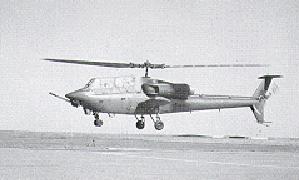Bell YAH-63
| Bell 409 / YAH-63A | |
|---|---|
 |
|
| A YAH-63A prototype | |
| Role | Attack helicopter prototype |
| Manufacturer | Bell Helicopter Textron |
| First flight | 1 October 1975 |
| Primary user | United States Army |
| Number built | 3 |
The Bell Model 409/YAH-63 was an experimental attack helicopter for the Advanced Attack Helicopter (AAH) competition. Hughes' Model 77/YAH-64, later developed into the AH-64 Apache, was selected over Bell's entry.
During the mid-1960s, United States Army initiated the Advanced Aerial Fire Support System (AAFSS) program to develop the Lockheed AH-56 Cheyenne for the anti-tank gunship role. The U.S. Army pursued the AH-1G HueyCobra as an interim type for the "jungle fighting" role. However the Army's broader concern was the task of protecting Western Europe from the legions of Warsaw Pact armor to the east.
In 1972, the Army conducted an evaluation between the Bell 309 KingCobra, the Lockheed Cheyenne, and the Sikorsky S-67 in a competitive fly-off. The fly-off began in the spring of 1972 and was completed in July. In August, somewhat to everyone's shock, the Army rejected all three competitors.
Difficulties delayed the AH-56 Cheyenne development. The Army canceled the Cheyenne program in August 1972. Controversy over the Cheyenne's role in combat and the political climate regarding military acquisition programs caused the Army to amend the service's attack helicopter requirements in favor of a simpler and more survivable conventional helicopter.
The Army sought an aircraft to fill an anti-armor attack role. The Army wanted an aircraft better than the AH-1 Cobra in firepower, performance and range. The aircraft would have the maneuverability to fly nap-of-the-earth (NoE) missions. To this end, the U.S. Army issued a request for proposals (RFP) for an Advanced Attack Helicopter (AAH) in 1972.
The Army specified that the AAH was to be powered by twin General Electric T700 turboshaft engines with 1,500 shp (1,120 kW) each. This was the same powerplant fit specified for a new Army utility helicopter competition that would be won by the Sikorsky S-70 Black Hawk. The AAH would be armed with a 30 millimeter cannon and sixteen BGM-71 TOW anti-tank missiles. The missile armament specification was later modified to include an alternate load of sixteen laser-guided AGM-114 Hellfire anti-tank missiles. Hellfire was then in development and promised greater range and lethality than TOW.
...
Wikipedia
